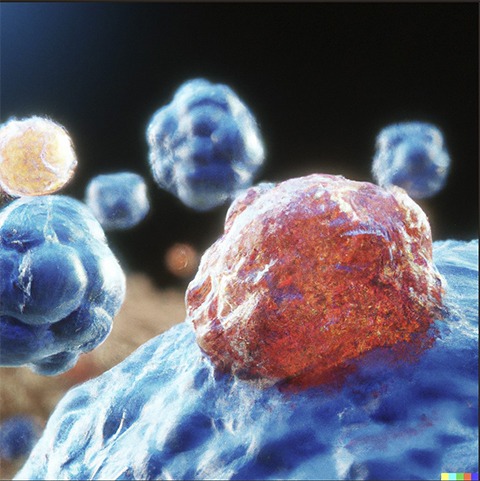Cholesterol synthesis and cancer
Too much cholesterol can cause disease. For instance, cholesterol is the starting material for producing steroid hormones, which drive certain cancers such as endometrial cancer. Therefore, controlling how cells acquire and store cholesterol helps keep the body healthy.
One way to acquire cholesterol is cholesterol synthesis, which involves multiple enzymes that influence the rate of reactions in the cholesterol synthesis pathway. In a recent study published in the Journal of Biological Chemistry, researchers at the University of New South Wales found that the active form of one key cholesterol synthesis enzyme, squalene monooxygenase, or SM, is upregulated in endometrial cancer tissues.

Andrew J. Brown, Hudson W. Coates and their team investigate how cholesterol synthesis is controlled. “Very little was known about the control of the cholesterol synthesis pathway, apart from this early rate-limiting step HMG CoA-reductase,” Brown said.
Eventually, the researchers found SM.
SM is involved in one of the slowest reactions in the pathway, meaning that it’s a key bottleneck in the entire pathway,” Coates said.
Thus, the amount of SM protein influences how much cholesterol can be produced.
At high cholesterol levels, SM recognizes it must be degraded and sends itself to the cell’s garbage disposal, the proteosome, to be fully destroyed. But sometimes, the proteosome machinery gets jammed and only clips off, or truncates, SM’s N-terminal regulatory domain.
“You then have this unleashed protein. Because it is lacking its N-terminus needed for inhibitory control, it becomes constitutively active,” Brown said. “We like to think of this as the enzyme going rogue.”
“This fragment of SM can no longer be sent to the garbage disposal,” Coates said. “Since there is nothing to stop this SM, it can essentially produce as much cholesterol as it wants to.”
Cancer biologists have been particularly interested in SM as a proto-oncogene, as it is needed for normal cell growth but promotes cancer cell growth when overactivated. In turn, it is a potential target for chemotherapy. Since SM is involved later in the pathway, targeting SM may effectively block cholesterol synthesis without affecting the production of other important molecules.
However, past studies have shown that inhibiting full-length SM enzyme does not turn it off but instead truncates and activates it.
“Knowing the biology of this truncation may give us an insight into how to better target SM,” Brown said.
Previously, the team saw that a lack of oxygen, or hypoxia, which is common in solid tumors, also truncates SM. To investigate whether truncated SM, or trunSM, and endometrial cancer are connected, the team analyzed and compared trunSM levels in samples of endometrial cancer tissue versus adjacent noncancerous tissue. They found that levels of both trunSM and the biomarker for hypoxia, HIF1alpha, significantly increase in the cancerous tissues, confirming their correlation.
The team then studied the relationship between trunSM and lipid droplets, or LDs, which are fat stores that can fuel cells. LDs bud off the membrane of the endoplasmic reticulum, or ER, and LD accumulation is broadly linked to cancer progression. Since SM is normally embedded in the ER membrane, the researchers wondered if truncation would allow the enzyme to move more freely and to LDs.
Using confocal microscopy and cell fractionation, they found that full-length SM does not associate with LDs, but trunSM does.
“We're really showing that this fragmented form of SM has very different properties to the full-length normal version,” Coates said.
Overall, their studies suggest that upregulated truncation may contribute to SM-related oncogenesis. Therefore, SM may be a viable chemotherapeutic target.
“If we could selectively target the rogue version in tumors, it might be the best way forward,” Brown said.
“If we can stop cells from producing this overactive fragment of SM, we might be able to reduce the amount of cholesterol that cancer cells produce and bring it back to a normal level,” Coates said. “That might help suppress their growth.”
ASBMB Today contributing writer Jay Thakkar contributed to this article.
Enjoy reading ASBMB Today?
Become a member to receive the print edition four times a year and the digital edition monthly.
Learn moreGet the latest from ASBMB Today
Enter your email address, and we’ll send you a weekly email with recent articles, interviews and more.
Latest in Science
Science highlights or most popular articles

The science of staying strong
Muscles power every movement, but they also tell the story of aging itself. Scientists are uncovering how strength fades, why some species resist it and what lifestyle and molecular clues could help preserve muscle health for life.

Bacteriophage protein could make queso fresco safer
Researchers characterized the structure and function of PlyP100, a bacteriophage protein that shows promise as a food-safe antimicrobial for preventing Listeria monocytogenes growth in fresh cheeses.

Building the blueprint to block HIV
Wesley Sundquist will present his work on the HIV capsid and revolutionary drug, Lenacapavir, at the ASBMB Annual Meeting, March 7–10, in Maryland.

Gut microbes hijack cancer pathway in high-fat diets
Researchers at the Feinstein Institutes for Medical Research found that a high-fat diet increases ammonia-producing bacteria in the gut microbiome of mice, which in turn disrupts TGF-β signaling and promotes colorectal cancer.

Mapping fentanyl’s cellular footprint
Using a new imaging method, researchers at State University of New York at Buffalo traced fentanyl’s effects inside brain immune cells, revealing how the drug alters lipid droplets, pointing to new paths for addiction diagnostics.

Designing life’s building blocks with AI
Tanja Kortemme, a professor at the University of California, San Francisco, will discuss her research using computational biology to engineer proteins at the 2026 ASBMB Annual Meeting.

